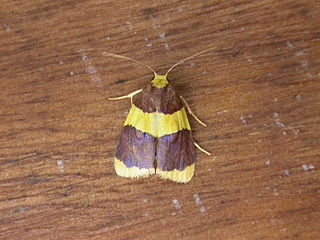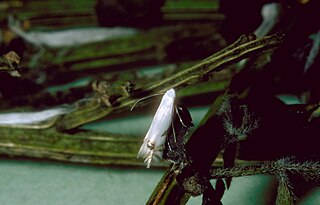
The Lecithoceridae, or long-horned moths, are a family of small moths described by Simon Le Marchand in 1947. Although lecithocerids are found throughout the world, the great majority are found in the Indomalayan realm and the southern part of the Palaearctic realm.

Heterallactis is a genus of moths in the family Erebidae erected by Edward Meyrick in 1886.
Heterotropa is a monotypic moth genus in the subfamily Arctiinae. Its single species, Heterotropa fastosa, is found in Australia's Northern Territory and Queensland. Both the genus and species were first described by Turner in 1940.

Philenora is a genus of moths in the subfamily Arctiinae. The genus was erected by Rudolph Rosenstock in 1885.

Scoliacma is a genus of tiger moths in the family Erebidae. The genus was erected by Edward Meyrick in 1886.

The Depressariinae – sometimes spelled "Depressiinae" in error – are a subfamily of moths in the superfamily Gelechioidea. Like their relatives therein, their exact relationships are not yet very well resolved. It has been considered part of family Elachistidae sensu lato or included in an expanded Oecophoridae. In modern classifications they are treated as the distinct gelechioid family Depressariidae.

Leucoptera is a genus of moths in the family Lyonetiidae. Its members are leaf borers many of which can cause severe damage to plant crops, such as coffee or apples.
Cuphodes is a genus of moths in the family Gracillariidae.

Xyloryctidae is a family of moths contained within the superfamily Gelechioidea described by Edward Meyrick in 1890. Most genera are found in the Indo-Australian region. While many of these moths are tiny, some members of the family grow to a wingspan of up to 66 mm, making them giants among the micromoths.
Graphosia approximans is a moth of the family Erebidae. It was described by Rothschild in 1912. It is found in New Guinea.
Graphosia pachygramma is a moth of the family Erebidae. It was described by George Hampson in 1914. It is found on New Guinea.
Graphosia phaeocraspis is a moth of the family Erebidae. It was described by George Thomas Bethune-Baker in 1908. It is found in New Guinea.
Graphosia polylophota is a moth of the family Erebidae. It was described by George Hampson in 1914. It is found on New Guinea. The small to medium-sized adults are often white, yellow, orange, or red with black markings on the forewings.

Graphosia stenopepla is a moth of the family Erebidae. It was described by George Hampson in 1914. It is found in Australia.
Graphosia ochracea is a moth of the family Erebidae. It was described by George Thomas Bethune-Baker in 1904. It is found in New Guinea. The habitat consists of mountainous areas.
Scaphidriotis camptopleura is a moth of the subfamily Arctiinae. It was described by Turner in 1940. It is found in the Australian state of Queensland.
Musotiminae is a subfamily of the lepidopteran family Crambidae. It was described by Edward Meyrick in 1884
The Lithosiina are a subtribe of lichen moths in the family Erebidae. The taxon was erected by Gustaf Johan Billberg in 1820.

Anacampsinae is a subfamily of moths in the family Gelechiidae.

Stathmopodidae is a family of moths in the moth superfamily Gelechioidea described by Edward Meyrick in 1913.









